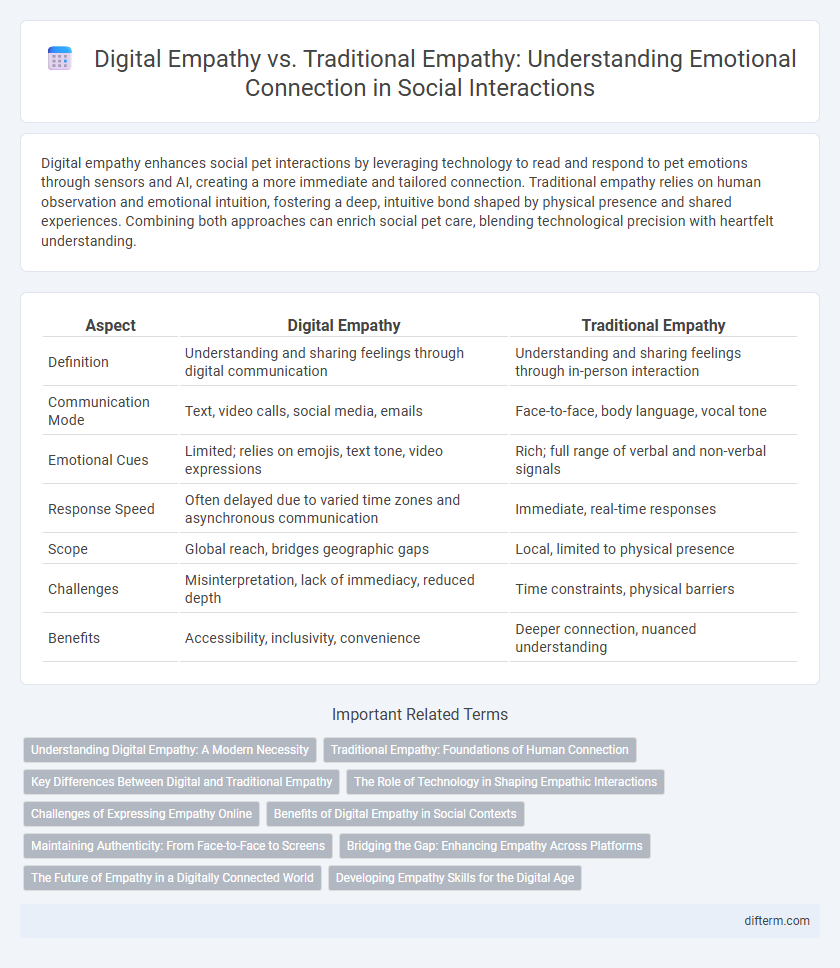Digital empathy enhances social pet interactions by leveraging technology to read and respond to pet emotions through sensors and AI, creating a more immediate and tailored connection. Traditional empathy relies on human observation and emotional intuition, fostering a deep, intuitive bond shaped by physical presence and shared experiences. Combining both approaches can enrich social pet care, blending technological precision with heartfelt understanding.
Table of Comparison
| Aspect | Digital Empathy | Traditional Empathy |
|---|---|---|
| Definition | Understanding and sharing feelings through digital communication | Understanding and sharing feelings through in-person interaction |
| Communication Mode | Text, video calls, social media, emails | Face-to-face, body language, vocal tone |
| Emotional Cues | Limited; relies on emojis, text tone, video expressions | Rich; full range of verbal and non-verbal signals |
| Response Speed | Often delayed due to varied time zones and asynchronous communication | Immediate, real-time responses |
| Scope | Global reach, bridges geographic gaps | Local, limited to physical presence |
| Challenges | Misinterpretation, lack of immediacy, reduced depth | Time constraints, physical barriers |
| Benefits | Accessibility, inclusivity, convenience | Deeper connection, nuanced understanding |
Understanding Digital Empathy: A Modern Necessity
Digital empathy involves recognizing and responding to emotions through virtual interactions, leveraging technology to foster meaningful connections despite physical distance. Unlike traditional empathy, which relies on face-to-face cues, digital empathy demands heightened sensitivity to tone, language, and context in online communication. Cultivating digital empathy is essential in modern society to enhance social relationships and support mental well-being in increasingly digital environments.
Traditional Empathy: Foundations of Human Connection
Traditional empathy forms the foundation of human connection by enabling individuals to deeply understand and share the emotions of others through face-to-face interactions. This embodied empathy relies on nonverbal cues such as facial expressions, tone of voice, and body language, fostering authentic emotional bonds and trust. Unlike digital empathy, traditional empathy creates a more immediate and profound sense of presence, crucial for building strong interpersonal relationships.
Key Differences Between Digital and Traditional Empathy
Digital empathy relies on interpreting tone and emotion through text, images, or video, often requiring enhanced emotional intelligence to compensate for the lack of physical cues. Traditional empathy involves direct, face-to-face interaction, allowing for immediate recognition of body language, facial expressions, and vocal nuances. The key difference lies in digital empathy's dependence on technological mediation, which challenges the depth and immediacy of emotional connection compared to the richer, more intuitive feedback loop in traditional empathy.
The Role of Technology in Shaping Empathic Interactions
Technology has transformed empathic interactions by enabling real-time, cross-cultural communication through digital platforms, expanding the scope of traditional empathy beyond face-to-face encounters. Digital empathy leverages artificial intelligence and machine learning to interpret emotional cues and provide personalized support, enhancing emotional understanding in virtual environments. Despite these advancements, challenges in authentic emotional connection and potential depersonalization persist, emphasizing the need for balanced integration between digital tools and human empathy.
Challenges of Expressing Empathy Online
Expressing empathy online presents challenges such as the absence of nonverbal cues like facial expressions and tone of voice, which are crucial in traditional empathy for understanding emotions. Digital empathy relies heavily on written text and emoticons, often leading to misunderstandings or perceived insincerity. The asynchronous nature of online communication can delay emotional feedback, reducing the immediacy and depth found in face-to-face empathetic interactions.
Benefits of Digital Empathy in Social Contexts
Digital empathy enhances social interactions by enabling real-time emotional recognition through AI-driven sentiment analysis, fostering deeper connections across virtual platforms. It bridges geographical barriers, promoting inclusivity and diverse perspectives by supporting multicultural communication in digital communities. This technology-driven empathy also aids mental health support, providing responsive and personalized care in online social networks, expanding the reach and effectiveness of traditional empathetic practices.
Maintaining Authenticity: From Face-to-Face to Screens
Maintaining authenticity in empathy shifts significantly from traditional face-to-face interactions to digital screens, requiring nuanced emotional intelligence to interpret non-verbal cues through virtual channels. Digital empathy relies on active listening, timely responses, and personalized communication to build trust and genuine connections despite physical separation. Effective use of video calls, emojis, and tone of voice in messages enhances the authenticity of empathetic exchanges in social contexts.
Bridging the Gap: Enhancing Empathy Across Platforms
Digital empathy leverages technology to recognize and respond to emotions through virtual interactions, using tools like AI-driven sentiment analysis and real-time emotional feedback. Traditional empathy relies on face-to-face cues such as body language and vocal tone to build deep emotional connections. Bridging the gap involves integrating digital empathy tools with human-centered communication strategies to create seamless, emotionally aware experiences across social platforms.
The Future of Empathy in a Digitally Connected World
Digital empathy leverages artificial intelligence and real-time data analytics to enhance emotional understanding across virtual platforms, surpassing the limitations of traditional empathy confined to face-to-face interactions. Immersive technologies like virtual reality enable users to experience others' perspectives with unprecedented depth, reshaping social connections and emotional intelligence in a globally connected environment. The evolution of empathy in digital spaces promises more inclusive and scalable emotional engagement, crucial for fostering trust and cooperation in increasingly virtual communities.
Developing Empathy Skills for the Digital Age
Developing empathy skills for the digital age requires understanding the nuances between digital empathy and traditional empathy, as online interactions often lack physical cues but still demand emotional intelligence and active listening. Digital empathy involves recognizing emotions through text, tone, and context, using tools like video calls, emojis, and virtual feedback to convey understanding and support. Enhancing these skills fosters stronger connections, reduces misunderstandings, and promotes inclusive communication across diverse digital platforms.
digital empathy vs traditional empathy Infographic

 difterm.com
difterm.com